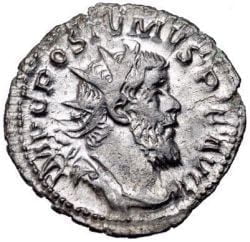Chapters
The Gallic Empire (Imperium Galliarum) was a self-proclaimed empire founded between 259 and 260 CE in the western part of the Roman Empire by the usurper Postumus. The organism survived until 274 CE. The state consisted of parts of the Roman provinces: Gaul, Spain, Betica, Britain.
New Creation
The crisis of the 3rd century CE clearly plagued all parts of the Empire. Border fights, the economic crisis, internal chaos and rotation on the throne caused more and more bold actions on the part of ambitious leaders. The crisis was aggravated by the news of the capture of the emperor Valerian I by the Sassanid Persians, after the Battle of Edessa in 259 CE. Power in Rome passed into the hands of his son – Galliena, who had to face many external threats.
A series of military revolts in the Danubian provinces of Pannonia led to the unveiling of the Rhine line defended by Postumus. Postumus had Upper and Lower Germania under his management and was considered a capable governor. He proved it, among other things, in the summer of 260 CE, when he repulsed the Frankish invasion on the Rhine. His victory was so successful that for the next 10 years there were no further invasions from this side. In this way, Postumus became with time one of the most influential and decision-making persons in the western part of the Empire. Galien’s young son – Salonin with his tutor Sylwan was in Colonia Agrippina (present-day Cologne). His father wanted to keep his son out of the Eastern fighting, and at the same time wanted to keep an eye on the ambitious Postumus.
About CE 260 Postumus, who had been the governor of the province of Germania so far, took advantage of the weakening of the army against the underage son of Emperor Galien, Salonin and his guardian, Silvanus. Both Salonina and Sylvanas had to be murdered. He soon mastered all of Gaul too. His sovereignty was also recognized by Spain and Britain. In the territory he conquered, Postumus created an empire independent of Rome, with his own senate and consuls (according to numismatics, Postumus held the office of consul five times) and with his own coin more valuable than the official one. The Gallic Empire also had its own Praetorian Guard. He announced his capital city either in Colonia Agrippina or in Augusta Treverorum (present-day Trier). An important city in his country was also Lugdunum (now Lyon).
In 261 CE Postumus repelled the attack of the Franks and Alemans who crossed the Rhine. In 263 CE Galien travelled west to deal with the self-proclaimed ruler. However, the operation turned out to be ineffective and he never undertook such actions again.
Lelian (Laelianus), one of his commanders who was made emperor by Legio XXII Primigenia in Mogontiacum (now Mainz). Postumus defeated and killed the enemy, but unexpectedly his own soldiers decided to kill Postumus on the news that they would not be able to plunder the city.
After Postumus’ death, the Gallic Empire was on the way to collapse. The Roman Emperor Claudius II the Gothic rebuilt Roman influence in Gallia Narbonensis and parts of Gallia Aquitania. It is possible that some Spanish provinces, previously ruled by the rulers of Trier, also recognized Roman authority.
After Postumus’ death, Marius became the emperor, who died shortly after taking office. Some sources say that he reigned only two days. However, according to numismatic sources, it is believed that he ruled for several months. The successor was Victorinus. It was recognized in Gaul and Britain, outside of Spain. The new emperor spent his reign suppressing rebellions and trying to regain the Gallic lands, which recognized power in Rome. Eventually, Victorinus in 271 CE he was murdered in Cologne by the jealous officer Attianus, whom he seduced his wife.
After Victorinus died, his mother Victoria took over orders over her son’s soldiers and used her influence to appoint an heir. With her support, the new Gallic emperor was Tetricus I, who was recognized in Britain and parts of Gaul. The new ruler had to deal with the barbarian invasions of Gaul. He recaptured the Gallia Aquitania provinces and the western part of Gallia Narbonensis. Tetricus took advantage of the fact that the Roman emperor Aurelian at that time had to contend with the rebellion of Queen Zenobia in Palmyra in the east. Tetricus I re-launched the courts of Trier, and in 270 CE. He named his son Tetricus II (Tetricus II) Caesar. The following year, Tetrykus II became co-consul.
The empire had to face another revolt led by Faustinus. During this time, Emperor Aurelian dealt with the Kingdom of Palmyra and focused on the war with the Gallic Empire. He went to Gaul, wherein 274 CE at the Battle of Catalaunum (sometimes called Châlons) he defeated Tetricus. According to sources, the ruler in the West was to ask for grace for himself and his son in exchange for capitulation. Scientists point out that this may have been Aurelian’s later invented propaganda story. It is certain, however, that Emperor Aurelian won a victory in the east and west of the Empire and definitely smashed the Gallic Empire. Imperium Galliarum was painlessly incorporated into the Roman Empire.
The Gallic Empire was a symptom of the gradual fragmentation of power in the Empire in the 3rd century CE. and evidence of a crisis of statehood.
List of Gallic Emperors |
|








